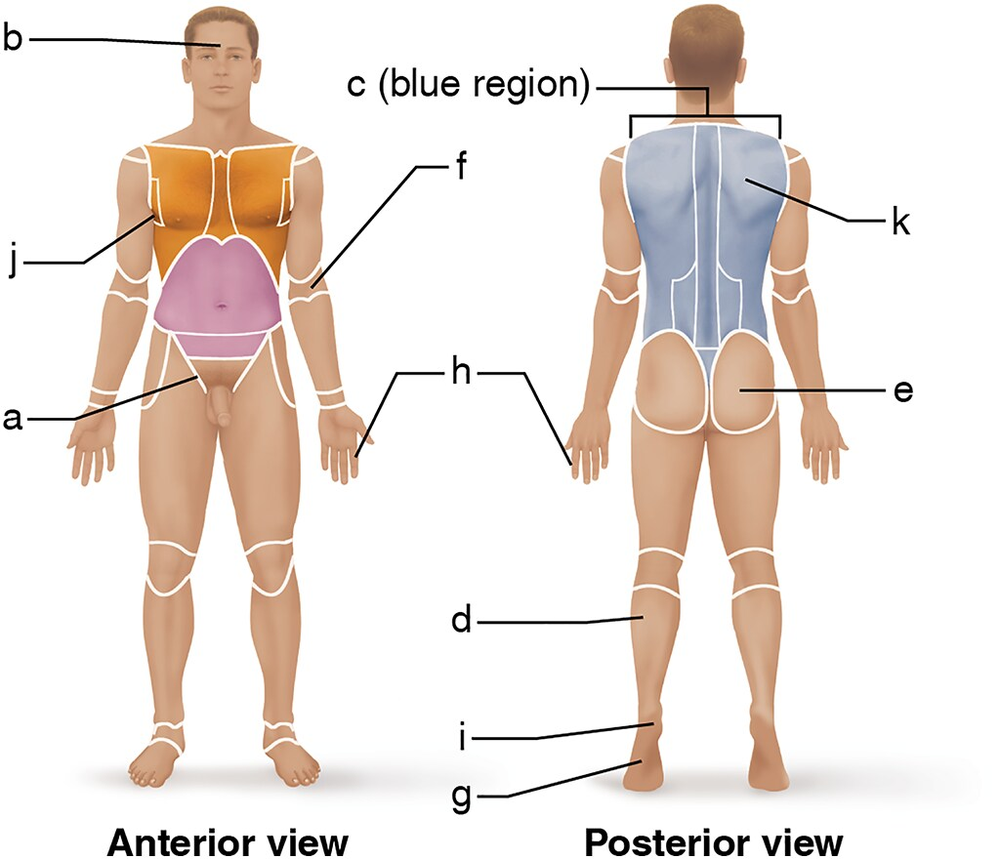 Back
BackProblem 1
Which level of organization consists of groups of cells with similar structures and functions? (More than one may apply.)
<IMAGE>
Problem 3
Using the terms listed below, fill in the blank with the proper term.
Anterior
Superior
Medial
Proximal
Superficial
posterior
Inferior
Lateral
Distal
Deep
The heart is located__________to the diaphragm.
The muscles are____________to the bone.
The shoulder is_____________to the elbow.
In anatomical position, the thumb is__________to the index finger.
The vertebral region is_____________to the scapular region.
The gluteal region is located on the____________surface of the body.
Problem 4a
Match each anatomical region shown in the image with the anatomical term that describes it.
_____1. Digital
<IMAGE>
Problem 4b
Match each anatomical region shown in the image with the anatomical term that describes it.
_____2. Dorsal
<IMAGE>
Problem 4c
Match each anatomical region shown in the image with the anatomical term that describes it.
_____3. Gluteal
<IMAGE>
Problem 4d
Match each anatomical region shown in the image with the anatomical term that describes it.
________ 4. Inguinal
Problem 4e
Match each anatomical region shown in the image with the anatomical term that describes it.
_____4. Plantar
<IMAGE>
Problem 4f
Match each anatomical region shown in the image with the anatomical term that describes it.
_____ 6. Frontal
<IMAGE>
Problem 4g
Match each anatomical region shown in the image with the anatomical term that describes it.
_____7. Calcaneal
<IMAGE>
Problem 4h
Match each anatomical region shown in the image with the anatomical term that describes it.
_____ 8. Sural
<IMAGE>
Problem 4i
Match each anatomical region shown in the image with the anatomical term that describes it.
_____9. Antecubital
<IMAGE>
Problem 5
Anatomical terms that apply to the backside of the body in the anatomical position include:
a. Ventral and anterior
b. Back and rear
c. Posterior and dorsal
d. Head and lateral
Problem 6
A neurosurgeon orders a spinal tap for a patient. Into what body cavity will the needle be inserted?
a. Ventral
b. Thoracic
c. Dorsal
d. Cranial
e. Pelvic
Problem 7
Which of the following groupings of the abdominopelvic regions is medial?
a. Hypochondriac, hypogastric, umbilical
b. Hypochondriac, lumbar, inguinal
c. Hypogastric, umbilical, epigastric
d. Lumbar, umbilical, iliac
e. Iliac, umbilical, hypochondriac
Problem 7
More than one choice may apply.
The base of the heart is its _______surface.
a. Diaphragmatic
b. Superior
c. Anterior
d. Inferior
Problem 9
Name the organs of the urinary system, and describe the general function of each organ.
Problem 9
Define anatomy and physiology.
Problem 11
On what body surface is each of the following located: nose, calf of leg, ears, umbilicus, fingernails?
Problem 12
Which of the following organ systems—digestive, respiratory, reproductive, circulatory, urinary, or muscular—are found in both subdivisions of the ventral body cavity?
Which are found in the thoracic cavity only?
In the abdominopelvic cavity only?
Problem 15
What is the mesentery? The peritoneum
Problem 15
A nurse informed John that she was about to take blood from his antecubital region. What part of his body was she referring to? Later, she came back and said that she was going to give him an antibiotic shot in the deltoid region. Where on his body did he get the shot? Before John left the office, the nurse noticed that his left sural region was badly bruised. What part of his body was black and blue?
Problem 16
Jennifer fell off her motorcycle and tore a nerve in her axillary region. She also tore ligaments in her cervical and scapular regions and broke the only bone of her right brachial region. Explain where each of her injuries is located.
Problem 17
Mr. Garcia is behaving abnormally, and doctors strongly suspect he has a brain tumor. Which medical imaging device—conventional X-ray, CT, PET, ultrasound, or fMRI—would be best for precisely locating a tumor within the brain? Explain your choice.

